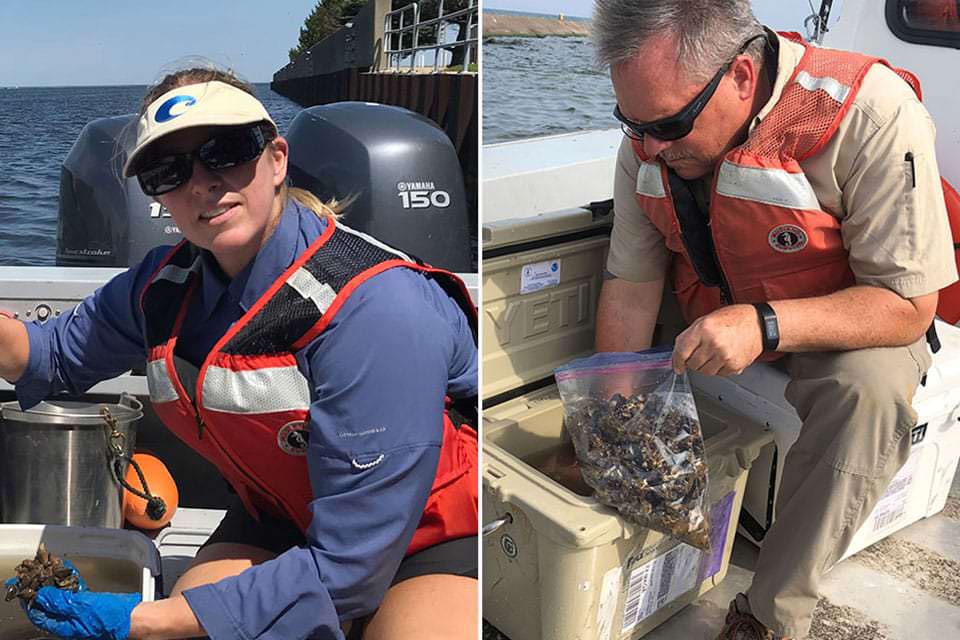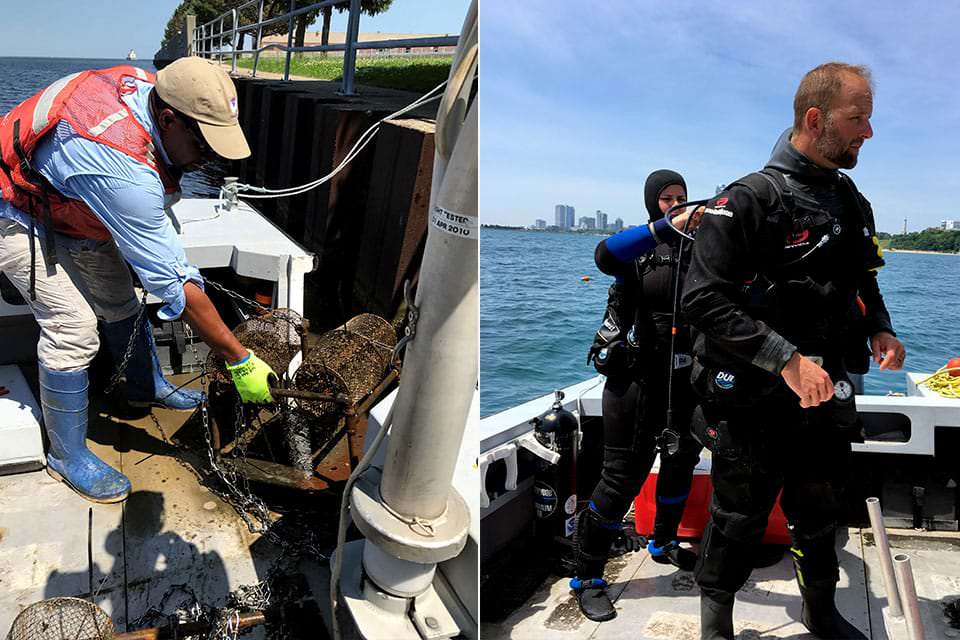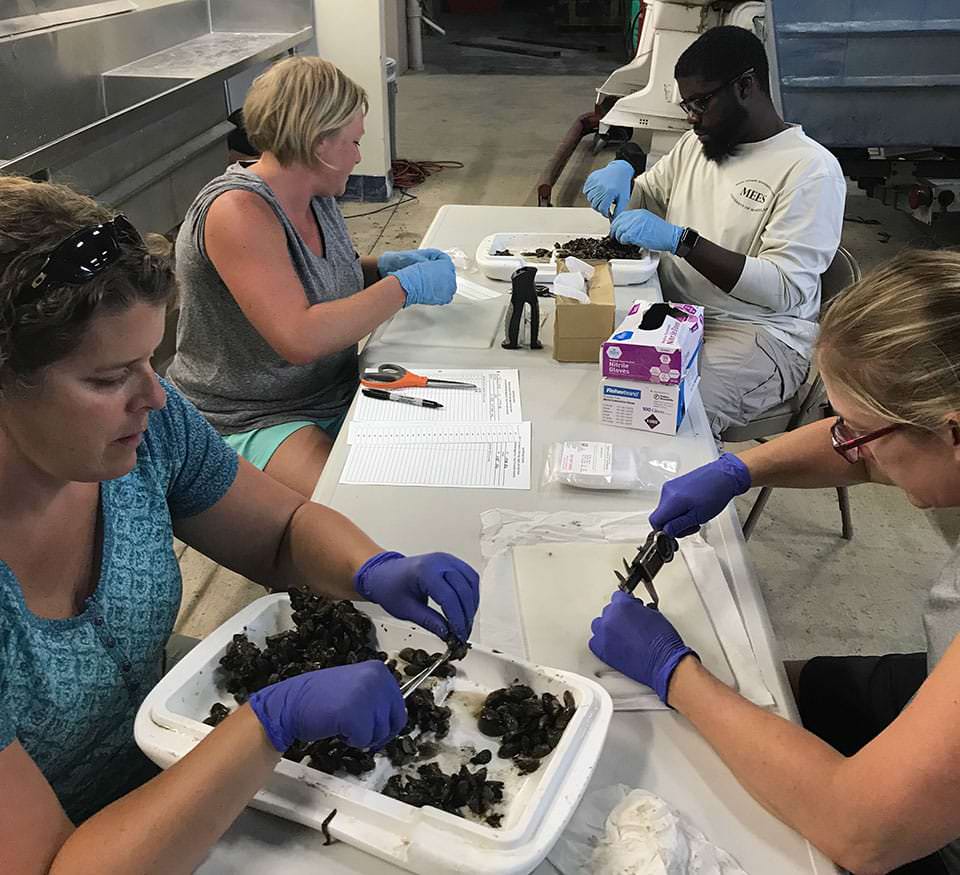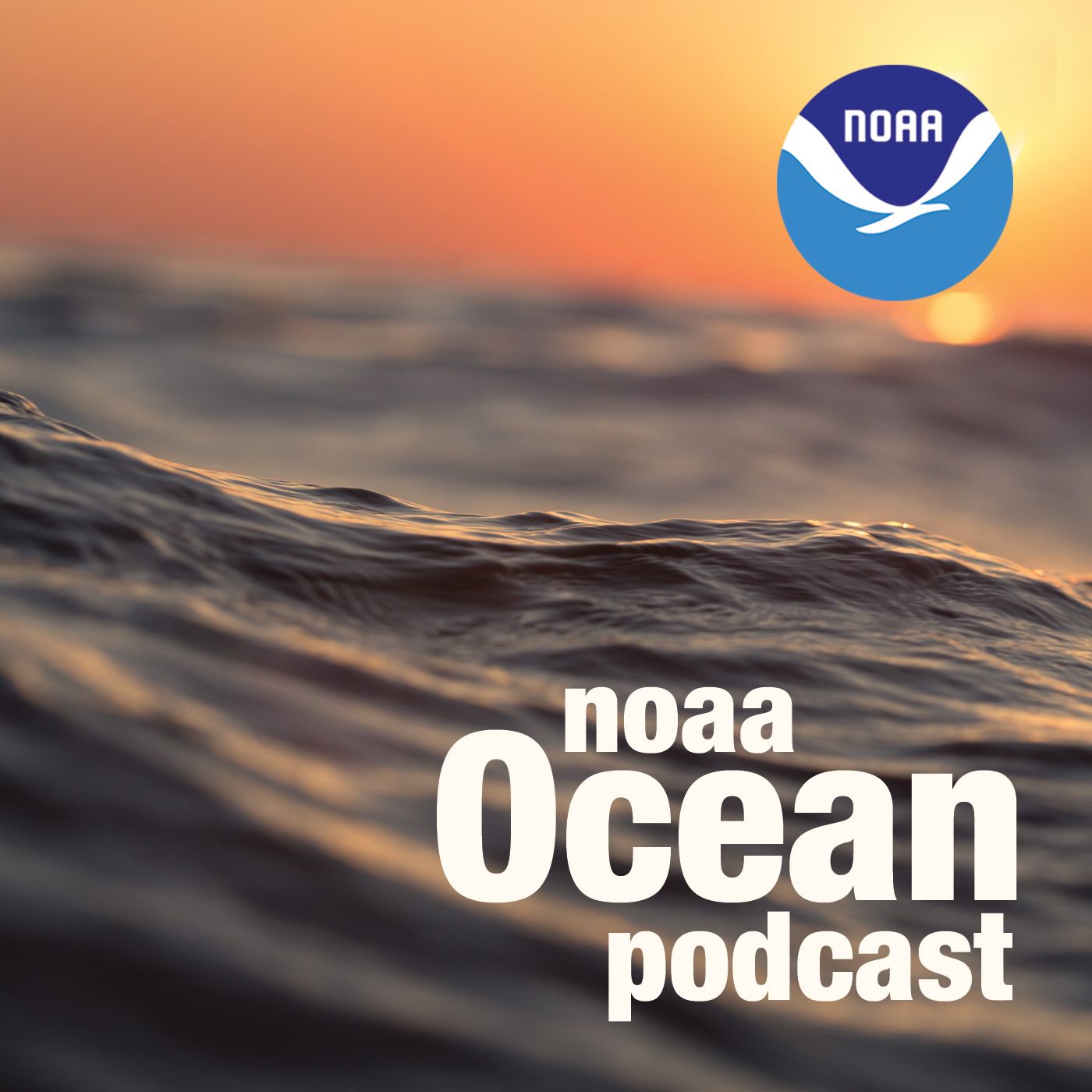The Microplastic-Mussel Connection: Part One
NOAA Ocean Podcast: Episode 39
In this episode, we hear about a NOAA-funded study that asked an interesting question: what if mussels could be used to learn more about microplastic pollution in our waterways? NOAA already runs a program that monitors chemical contaminants in our coastal waterways and Great Lakes by sampling mussels and oysters, called the Mussel Watch program. So wouldn’t it be great to tap into Mussel Watch to also learn more about plastics in our environment? Spoiler alert: the study didn’t turn out quite as expected. This is part one of a two-part episode.

Podcast guests Amy V. Uhrin, chief scientist for NOAA’s Marine Debris Program, and Ed Johnson, physical scientist with NOAA's Mussel Watch Program. Here, Amy and Ed are shown collecting samples of invasive zebra mussels on a research vessel in Lake Michigan.
Transcript
HOST: This is the NOAA Ocean Podcast. I’m Troy Kitch. This is part one of a two-part episode. Today, we’re going to hear about a NOAA-funded study that asked an interesting question: what if mussels — the seafood variety, not the kind people work at in the gym — could be used to learn more about microplastic pollution in our waterways? You see, NOAA already runs a program that monitors chemical contaminants in our coastal waterways and Great Lakes by sampling mussels and oysters. It’s called the Mussel Watch program. It’s the longest continually running scientific monitoring program of its kind in the nation.
So wouldn’t it be great to tap into Mussel Watch to also learn more about plastics in our environment? As you’ll hear, mussels are uniquely suited to serve as monitoring devices because they stay put in one place and filter vast amounts of water while accumulating the chemicals found in the water. And researchers have shown that, in the lab, mussels also ingest a lot of tiny plastic particles floating around in the water. So measuring this in the wild over long spans of time could teach researchers a lot about the effects of microplastics in the environment, which is something we know little about. Spoiler alert: the study didn’t turn out quite as expected.
In part two of our podcast, our guests talk about the study more broadly: how the scientific process works, how unexpected results are often part of that process, and how conducting a study in the field is so different than a study conducted within the controlled environment of a lab. It’s a fascinating look at how science works in the wild and you don’t want to miss it.
We’re joined by Amy Uhrin, chief scientist for NOAA’s Marine Debris Program. Amy’s team came up with the idea for the study — and her job, more broadly, is to look for gaps in marine debris research where the program can make the most difference — mainly through funding studies like the one we’ll talk about today, which was conducted in collaboration with scientists at Loyola University in Chicago. The study we’re talking about was finalized in July 2020 and it’s called, “Microplastic co-occurence with chemical contaminants in invasive mussels in Lake Michigan.”
We’re also going to hear from Ed Johnson, a physical scientist with the Mussel Watch program, which is part of NOAA’s National Centers for Coastal Ocean Science, or NCCOS for short. And since the study piggy-backed on the existing Mussel Watch program, Ed is going to fill us in on what this program is all about.
A warning that we recorded this over the internet so the audio quality may be a bit spotty in places.
Thank you both for joining me today. Amy, let’s start with the basics: what exactly are microplastics?

Left image: Kimani Kimbrough, NOAA physical scientist with the Mussel Watch program, recovers a mooring with caged mussels near the seawall at Jones Island wastewater treatment plant in Milwaukee, Wisconsin. Right image: Shelly Tomlinson, NOAA research oceanographer, and Beau Braymer, Cardinal Point Captains Northeast regional manager with NOAA's Great Lakes Environmental Research Laboratory, prepare to dive for mussels in Milwaukee Bay, Lake Michigan.
AMY UHRIN: Microplastics are small plastic pieces that are less than five millimeters in their longest dimension. And there are two types of microplastics: primary and secondary. Primary microplastics are designed for commercial use, so they are specifically made to be that small. So these are things you might have heard of, like microbeads that you find in personal care products and virgin resin pellets and spheres, which are the feedstock from which plastic products are made. And then secondary microplastics result from the breakdown of larger plastic items like plastic water bottles. And the items break down due to environmental exposure, particularly solar UV radiation and mechanical forces like wind that might cause abrasion of the items and cause it to break down, or waves on a shoreline. And then, lastly, we have microfibers, which are considered to be microplastics. But these are the small fibers that are shed from synthetic clothing and synthetic textiles, such as plastic fishing nets.
HOST: And what you’re interested in learning more about is what these microplastics are doing in our environment or what effects they are having on animals?
AMY UHRIN: A number of different organisms have had interactions with marine debris. So there have actually been over 900 species of organisms identified, including sea birds, marine mammals, turtles, fish, and invertebrates that have either ingested or become entangled in marine debris. So pretty much at every level of the aquatic food chain. What is not clear to scientists is the extent to which these types of interactions with plastic pollution — how they end up affecting species at higher levels of organization. So at the population or community level. Because if you start to have population or community-level impact, this could have ramifications for the functioning of entire ecosystems, and for our own economy and well-being, because many affected species have high commercial value as seafood resources. So there are whole fisheries organized around these species, there are animals that we eat, and so if you think about the human health side of things, if we’re eating these animals and they’re laden with plastic, that could be a problem.

Left to Right: Shelly Tomlinson, NOAA research oceanographer; Katie Miller, NOAA marine scientist; Ammar Hanif, 2018 NOAA Knauss Fellow; and Amy Uhrin, NOAA Marine Debris Program chief scientist, process mussels from Lake Michigan at the University of Wisconsin-Milwaukee School of Freshwater Sciences. Mussel samples were analyzed for body burdens of chemical contaminants, metabolomics, and biomarkers.
HOST: This is where the Mussel Watch program comes into the picture. It's is a nationwide program, but you focused in on the work the program is doing within the Great Lakes for this study.
AMY UHRIN: We wanted to be able to take advantage of an existing contaminant sampling program, which is NOAA’s Great Lakes Mussel Watch, and assess whether the same invasive freshwater mussels that they sample in the Great Lakes may also be good candidates as biomonitors for microplastic. So we looked at the concentration of microplastics in mussel tissue as a function of both the size of the mussel and as a function of its sampling location. And this involved analyzing mussels from relatively clean reference sites and also from sites having various proximity to pollution sources. We had a sampling site located at the outfall of a wastewater treatment plant, and we had a site located at the confluence of two rivers that drain the Milwaukee metro area and empty into Milwaukee Bay. And then the final objective was to test for any relationships between the concentration of chemical contaminants found in the mussels and the concentration of the microplastics found in the mussels to see if possibly, maybe, some of the contaminant load was being derived from microplastics.
HOST: Now, before we get into the details of what the study found, Ed I wanted to ask you to talk a bit more depth about Mussel Watch. How do you describe what this program is about?
ED JOHNSON: So Mussel Watch is first and foremost a chemical contaminant monitoring program to assess the chemical concentrations across a large geographic area and how those concentrations change over time in terms of years or decades.
HOST: And why mussels and oysters?
ED JOHNSON: They’re cosmopolitan species, meaning that they live in large groups. They typically are living as a unit, the same species in one location. They’re sedentary organisms, that is they don’t move around like fish or birds or other aquatic animals. In some species they have an organ that helps them attach to hard substrates so they can’t move at all. They’re also very good at concentrating chemicals from the water. This concentration of chemicals into their tissues can increase they levels of contaminants by a hundred to a hundred thousand times in the tissue over the level that would be occurring in the water that they live in, and that makes it easier to measure the chemicals. The organisms bioaccumulate these chemicals from the water, and the fact that they do that makes it important for us to understand the potential there for organisms that we may eat, or these contaminants may move into the food chain to other organisms that we may eat. So there are potential human health connections there. Bivalves also exhibit a low ability for many contaminants to metabolize them, to break them down and excrete them. And you can go back year after year to these stable local populations and harvest bivalves without seriously impacting the population where you harvested them from.
HOST: And you have monitoring or sampling sites located all around the nation in our coastal waterways, right?
ED JOHNSON: There are about a half a dozen species that we look at nationwide. Our sampling locations include Alaska, Hawaii, Puerto Rico, as well as the Atlantic, Gulf, and Pacific coasts. We don’t have that big of a team, so we’ve been successful at partnering with local and state governments to help us in their respective coastlines to collect these bivalves for us. The exception is the Great Lakes. We have always done the collections in the Great Lakes, beginning in 1992, and every year since then.
HOST: How many different sampling sites are we talking about?
ED JOHNSON: We’ve got 150 or more sites in the Great Lakes alone, that I'm not including in the 300 sites nationwide. We were the ones to establish these sites in the Great Lakes, and we have the boat resources and staff resources to help us complete that mission.
HOST: What’s it like to maintain a program of this size over the span of decades.
ED JOHNSON: Long-term monitoring programs are hard to maintain consistency as techniques evolve. What’s unique about this program: we’re consistent, long-term monitoring, and integrated assessments. And we’ve developed tools and methods of environmental assessment and forecasting. In addition, we’ve instituted quality assurance protocols; these are critical for ensuring the comparability of data over time. There are a lot of chemicals of emerging concern out there that we know relatively little about. So that’s where our focus is today. We know what’s happened with the legacy chemicals, the chemicals that have been banned — the PCBs and the DDTs from the '70s. We’re not so focused on those today. We’re focused on emerging chemicals that we know relatively little about. These chemicals at low concentrations could potentially have very insidious and serious effects on aquatic life, and we need to determine that.
HOST: And with this particular study, this is the first time Mussel Watch has looked at microplastics?
ED JOHNSON: This is the first time we’ve done that. But I would like to add that the program has been very involved historically and presently to look at bivalve health indicators. Not just what chemical contaminants are in the tissues of these organisms, but what are the characteristics that the organism is telling us about their overall bivalve health. One of the things we’ve done for a long time is we've looked at the community of parasites that live in the tissues of bivalves. Some of these are harmful, some of these are not. But we can look at the community of parasites in the tissue of oysters, for example, along the Atlantic coast, and as ocean warming increases, the community of parasites will shift to that community of parasites that may be at lower latitudes closer to the equator. So we potentially, then, can use that type of information to inform us on things as complicated as climate change and its effects on the ocean.
HOST: Amy, I want to get back to the study now and ask for your perspective on why looking at microplastic concentrations in bivalves was a good fit for what you wanted to investigate.
AMY UHRIN: For any organism to be considered a biomonitor, ideally the organism should be globally distributed, it should be abundant, and it should be known to respond to your contaminant of interest. And these were are all the case for the freshwater mussels in the Great Lakes. That’s why the Mussel Watch program uses them. But in addition, something that’s good about bivalves for biomonitoring is that they are sedentary so they don’t move, and they often form reef type structures. So there are a lot of them and they are easy to collect. Also, relative to their size, they filter a lot of water, and they often can retain the tiny particles that are found suspended in the water, which includes chemicals and microplastics. So they are effectively serving as a water sampling device. And then lastly, and I mentioned this before, a lot of these bivalves are important as a seafood resource. And for bivalves in particular, those that are eaten, we eat the whole animal. So there is the potential human health concerns and then the economic concerns because there is a lot of industry surrounding some of these bivalve species.
HOST: Could you talk a bit about what you knew going into this study, and what the Mussel Watch study confirmed?
AMY UHRIN: A lot of the work with these particular invasive freshwater mussels had been done in the laboratory. So we knew that when these mussels were exposed to microplastics of a particular size and of a particular concentration in the lab, they did ingest them. But they hadn’t yet been documented as coming from mussels collected in the wild. So we did learn that, yes, these mussels do ingest microplastics in the wild. And we learned that microfibers were actually the most common type of microplastic that was ingested. And this is interesting because it’s consistent with previous studies of microplastics in the Milwaukee Harbor food web, and it also aligns with data that has been collected on other bivalve species that have been studied in this region and globally and have been analyzed for microplastics. And also the range of microplastics that we found in our bivalves are consistent with values that were published from other studies for both freshwater and saltwater species.
HOST: What were some of the other results of the microplastics study?
AMY UHRIN: We were actually a little surprised by our results because they weren’t as clear as we thought they would be. So we expected that we would see more plastic in the bigger mussels, and we would see more plastic in these areas that were closer to some of these pollution sources. But we really had mixed results. What happened was, there was a lot of variation involved, and so the microplastic concentrations in the mussels varied a lot among the different size classes. So it wasn’t always the largest mussels that had the most microplastic. And there was a lot of variation in microplastic concentration across the different months that we sampled. Basically, there was so much variation because of that, that it was hard to really tease apart what was going on at a particular site in Milwaukee Bay, because so much variation was happening in other areas. So it was kind of difficult to definitively say, yes, there were more microplastics in mussels here versus there. And so that led us to conclude that, you know, possibly these freshwater invasive mussels might not serve as a good biomonitor for microplastic pollution in the Great Lakes.
HOST: We continue our conversation with Amy and Ed in part two of this episode, where you’ll hear more about the results of this pilot study, how the study was designed, some of the challenges of field work, and how when scientists get mixed results like they did in this study, it isn’t good or bad. It’s a valuable part of the scientific process. Amy and Ed, thank you both for taking the time to talk about your work. Check our show notes or go to the next episode in your podcast player to hear part two of the Microplastic Mussel Connection. This is the NOAA Ocean Podcast. Thanks for listening — and subscribe to us in your podcast player of choice so you never miss an episode. And please leave us a rating on iTunes. It’ll help more people find our show.

From corals to coastal science, connect with ocean experts to explore questions about the ocean environment.
Social